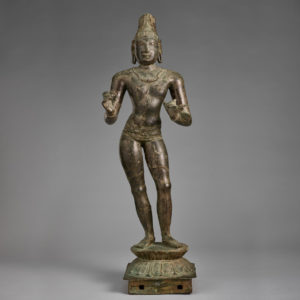The museum remains closed today due to power outage. Watch this space for updates.
The museum remains closed today due to power outage. Watch this space for updates.
The divine body of a mighty god rendered in elegant bronze.

The Hindu deity Shiva
Approx. 1300–1500
India; Tamil Nadu state
Bronze
The Avery Brundage Collection, B69S14
A product of the famous bronze-casting workshops of medieval South India, this image of Shiva projects the perfection of the deity. Following the style of the time, the artist has exaggerated the broadness of the figure’s shoulders and the narrowness of the waist, creating a beautiful, even sensuous, divine body. Like other bronze images of Hindu gods, this statue was designed to be carried through the streets during ceremonial processions to interact with worshipers, conferring blessings and receiving devotion.

Shiva, one of the highest gods of Hinduism, has a complex character. He both creates and destroys the universe. He is an ascetic practicing extreme control of the senses and a devoted family man. At some moments, he shows tenderness and at others, fury. Visual artists, poets, musicians, dancers, and storytellers recount Shiva’s stories and describe his perfection. The sculptor of this artwork, following the style of the time, has exaggerated the broadness of the figure’s shoulders and the narrowness of the waist, and treated lines such as the jeweled chain on the lower right leg and the sacred thread across the chest in a hyper-elegant manner. Devotion to Shiva is conveyed not just in artworks but also in intensely expressive poems like this one: Pure gold, first being, — Adapted from Indira Viswanathan Peterson, “Poems to Siva: The Hymns of the Tamil Saints” (Princeton, NJ: Princeton University Press, 1989), 11. Shiva’s dreadlocked hair, a fashion still worn by many Indian ascetics or yogis today, has some stories to tell. The crescent moon, barely visible in Shiva’s dreadlocks, reminds us of his power over the cycles of the universe and time. Ganga, the goddess of the great River Ganges, also nestles in Shiva’s locks, reminding us of Shiva’s role as protector of the earth. When Ganga, in her form as a river, was sent from the heavens to earth, Shiva broke the river’s fall with his matted hair to save the earth from great destruction. How did the bronze sculptor create such a figure? With a thousand year tradition, South Indian bronze sculptures are among the great artworks of the world. Sculptors first model the figure to be made in wax and cover the wax figure in clay. This gets baked to harden the clay and melt out the wax. Next, they pour molten bronze into the mold. When the bronze cools and hardens, they break off the clay and then clean and polish the metal. A wax model has turned into a sophisticated work of bronze. Sculptors in South India continue to cast bronze figures using these time-honored methods today — the old traditions have survived uninterrupted. Images of Hindu gods are honored as sacred embodiments of the deity. In South Indian temples, major deities such as Shiva are represented by both a stone image in the central sanctuary and a bronze one that can be taken out in procession through the neighborhood. The stone image is understood to be rooted, immovable, and permanent. A bronze processional image like this one, on the other hand, is mobile and dynamic, allowing the deity who resides in it to see and be seen by thousands of worshipers, and to interact with them. An essential practice in Hindu worship is for the deity and the worshiper to see each other (darshana). The deity confers blessings and divine grace, and the worshiper offers humble devotion in return. In the lower part of the base of this sculpture there are holes likely used to help secure the image to a palanquin or chariot. Such a vehicle was used to convey the image, decked with elaborate textiles, jewelry, and flowers, through the streets during ceremonial processions.
The Divine Body
living in grove-encircled Pulamankai, he is my own;
he is music, he is like the light of the morning sun.
Shiva’s Hair Tells a Story
Making the Sculpture
A Mobile Bronze Image